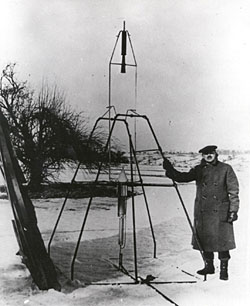
On March 16, 1926, in Auburn, Massachusetts, Dr. Robert H. Goddard launched the world's first liquid-propelled rocket, setting the course for future developments in rocketry. He launched the rocket from his outdoor laboratory, an open field on the Asa Ward farm. Since his childhood, Goddard had been fascinated with the thought that a rocket could be constructed that could reach the moon or even Mars. In 1914 Goddard received two U.S. patents that still remain fundamental documents in the field of rocketry--one for the design of the nozzle combustion chamber that allows the introduction of liqid fuel into the chamber and the other for the design of a multistage rocket for high altitude flight. In the following three years, Goddard received 70 patents for rockets and rocket apparatuses. He worked with the U.S. Army Signal Corps during World War I before returning to Auburn and his experiments with liquid propulsion. On November 1, 1923, Goddard static tested a rocket engine fueled with liquid oxygen and gasoline supplied by pumps on the rocket and by December 1925, this engine was operated independently of the testing frame.
The practical culmination of Goddard's work came on March 16, 1926 when he launched the world's first successful liquid-fueled rocket. The slim 10-foot cylinder reached an altitude of 41 feet, flew for two-and-a-half seconds and fell to the ground 184 feet from the launching frame. Goddard's final launch from Auburn, on July 17, 1929 was also a historic first. The 11-foot rocket carried an aneroid barometer, thermometer and a camera triggered when the parachute opened. All three instruments operated successfully and were recovered. The roaring rocket was heard throughout the town and some observers, thinking it was an airplane in flames, called for ambulances. The wire services quickly reported that Dr. Goddard's moon rocket had exploded violently. Despite the negative publicity, this event caught the attention of Charles A. Lindbergh, who was instrumental in obtaining substantial support from the Guggenheim Foundation for Goddard's research. Another grant from the Smithsonian Institution enabled Goddard to move his laboratory to Roswell, New Mexico, where on December 30, 1930, a rocket achieved an altitude of 2,000 feet and a speed of 500 miles per hour. A little over four years later, Goddard sent up the first rocket equipped with a gyroscope, which rose to 4,800 feet and traveled a horizontal distance of 13,000 feet. However, it was not until the appearance of the German V-2 missile in 1943 that the significance of Goddard's research was fully recognized and his work seriously studied by American scientists.
Visit the National Park Service Travel American Aviation to learn more about Aviation related Historic Sites.
Last updated: August 22, 2017
